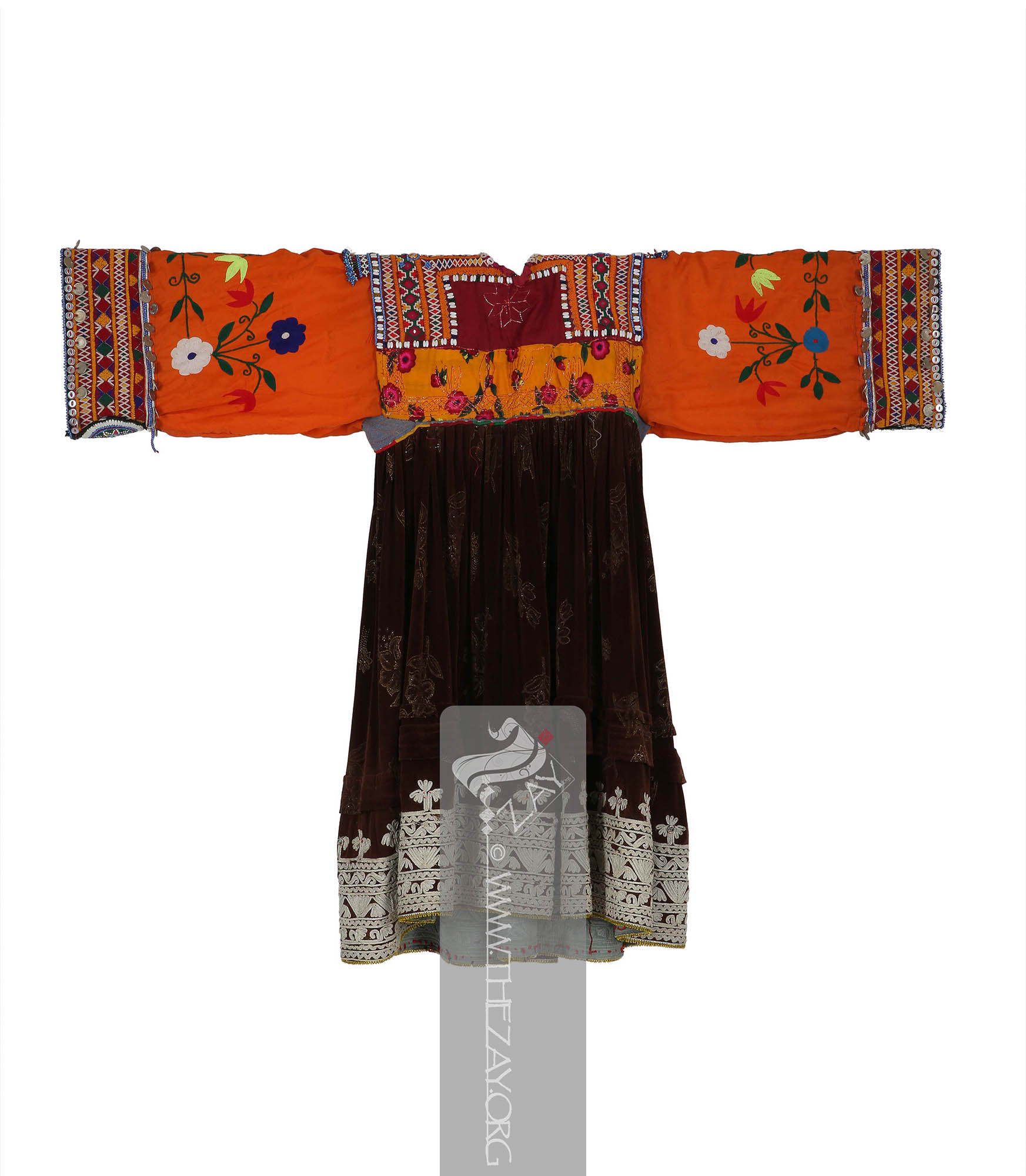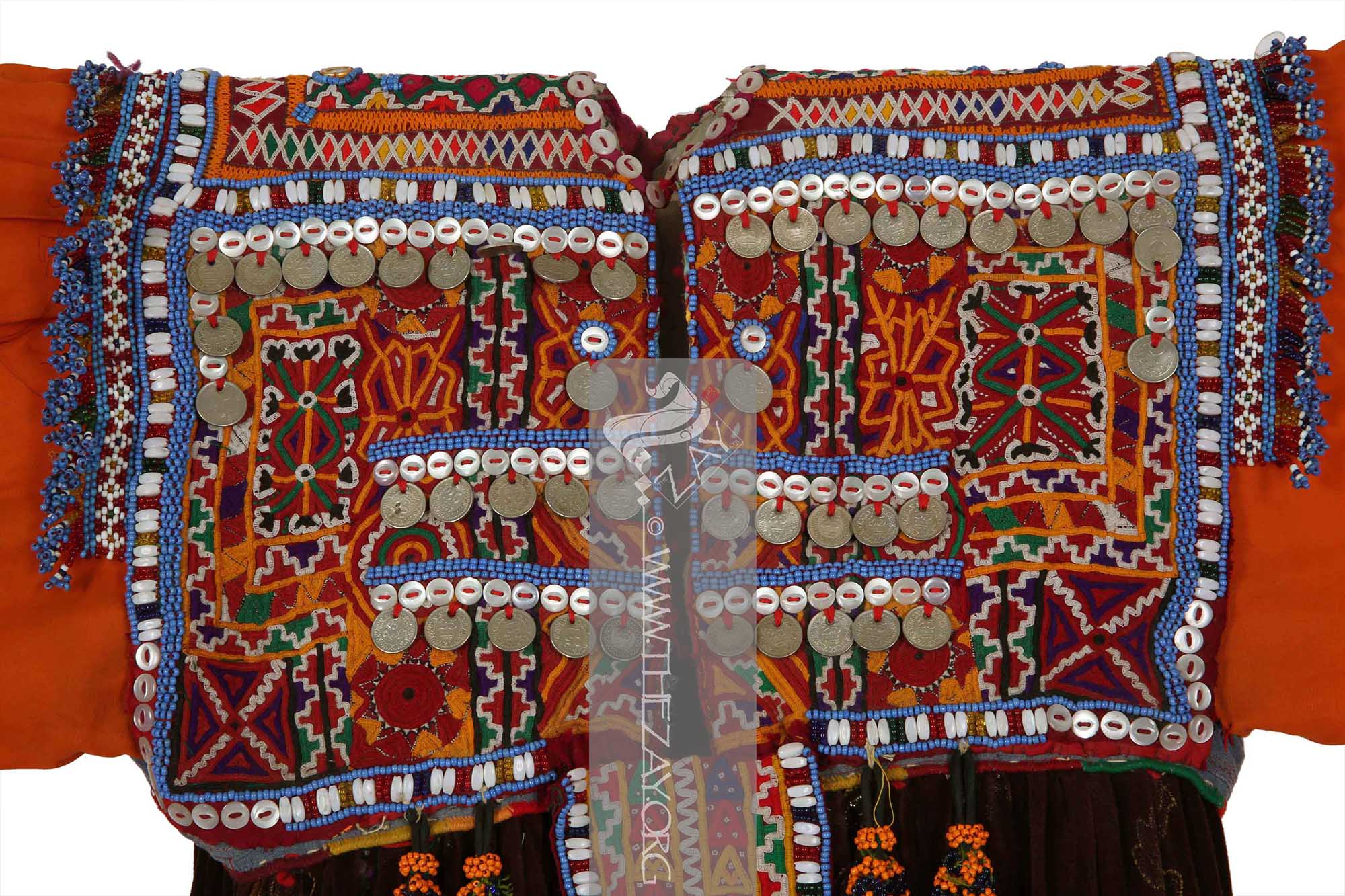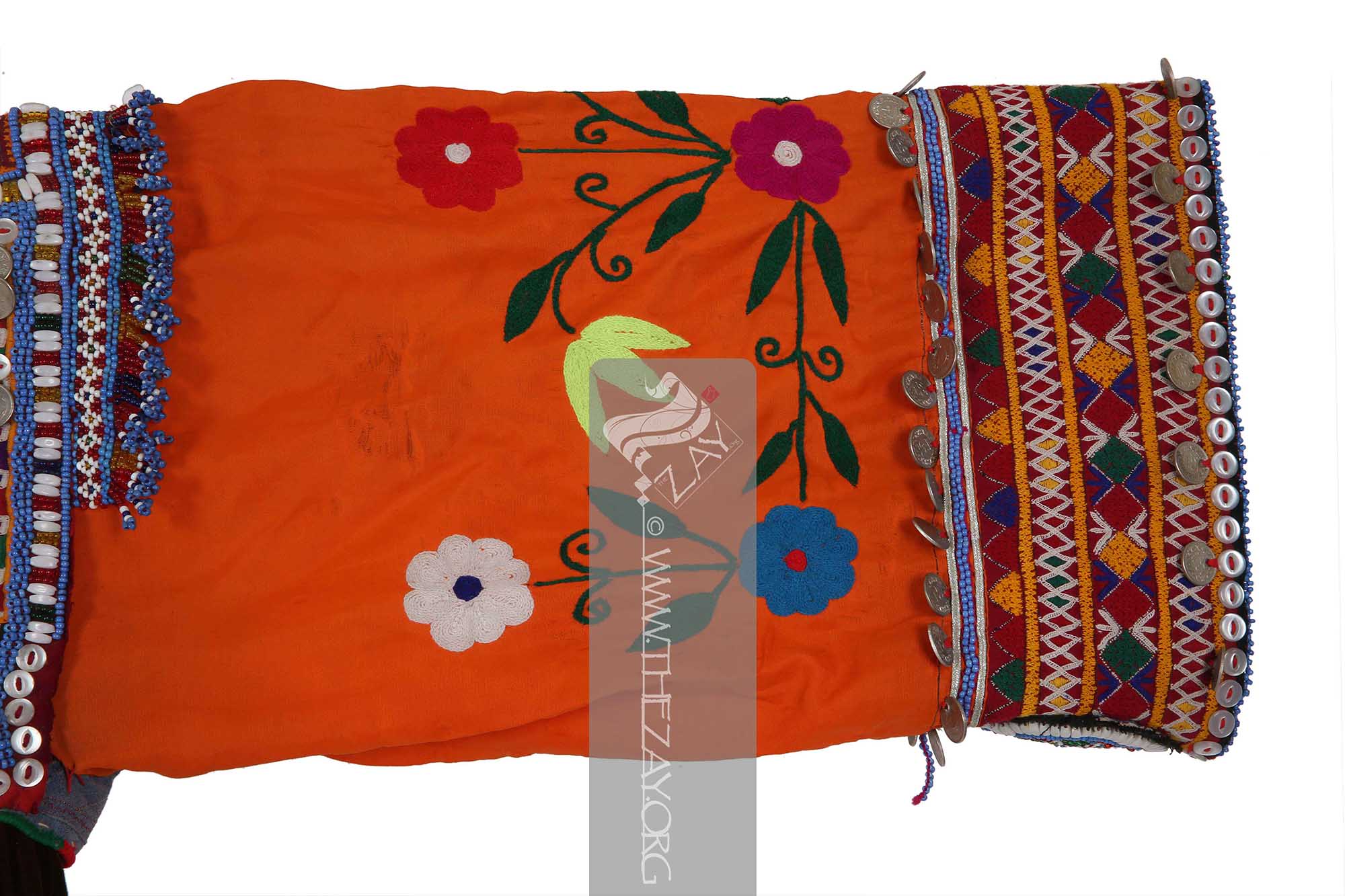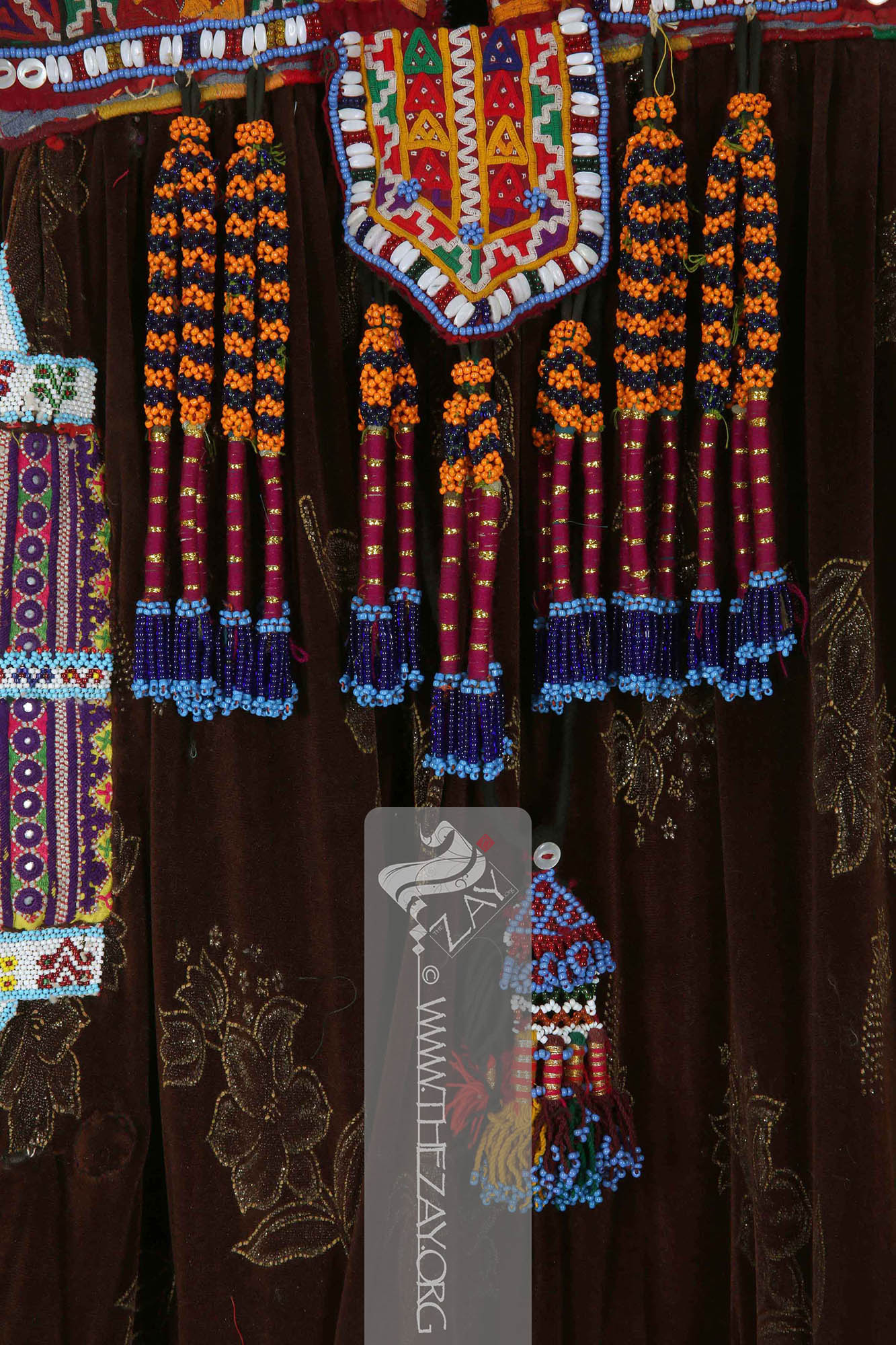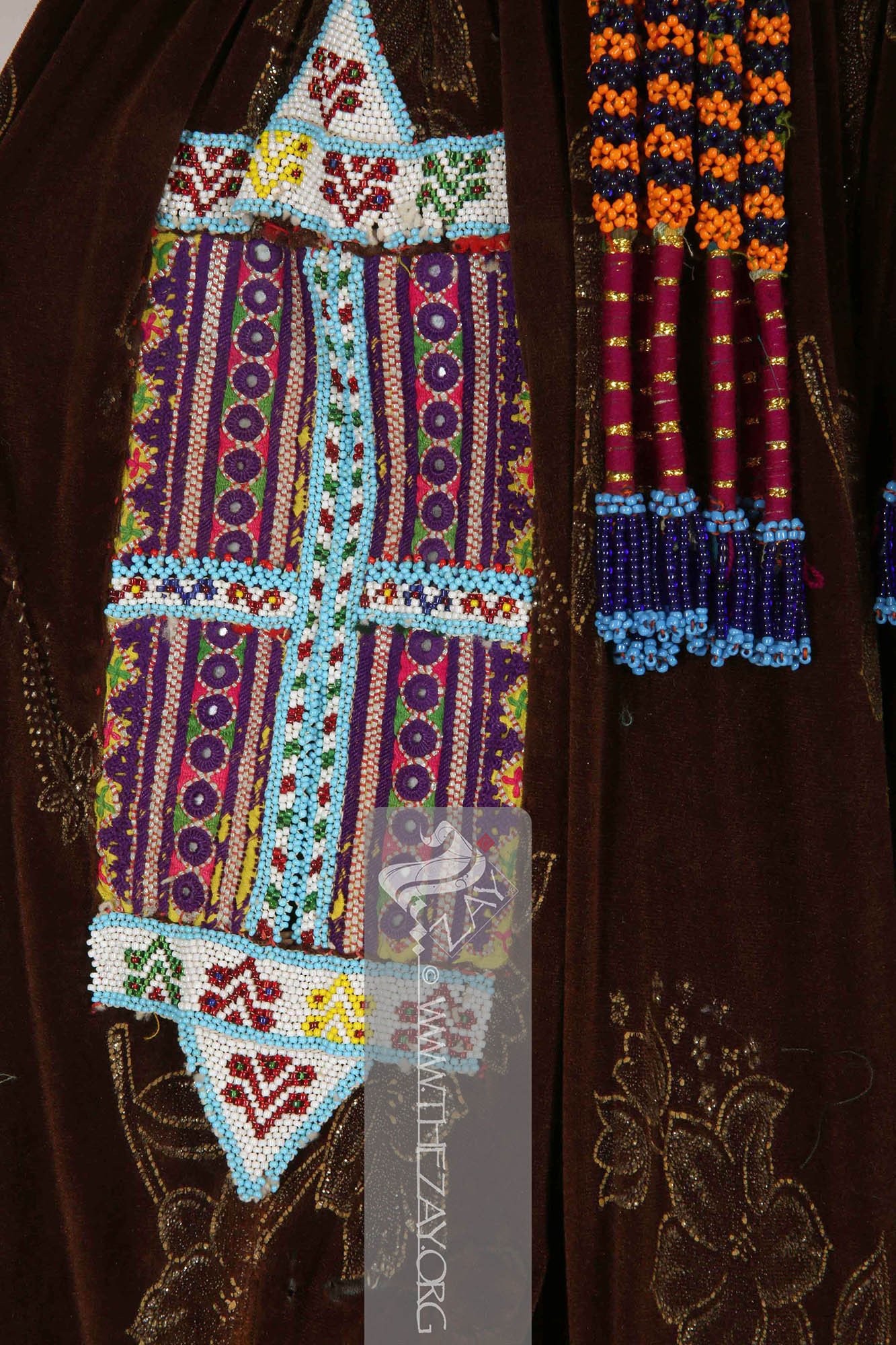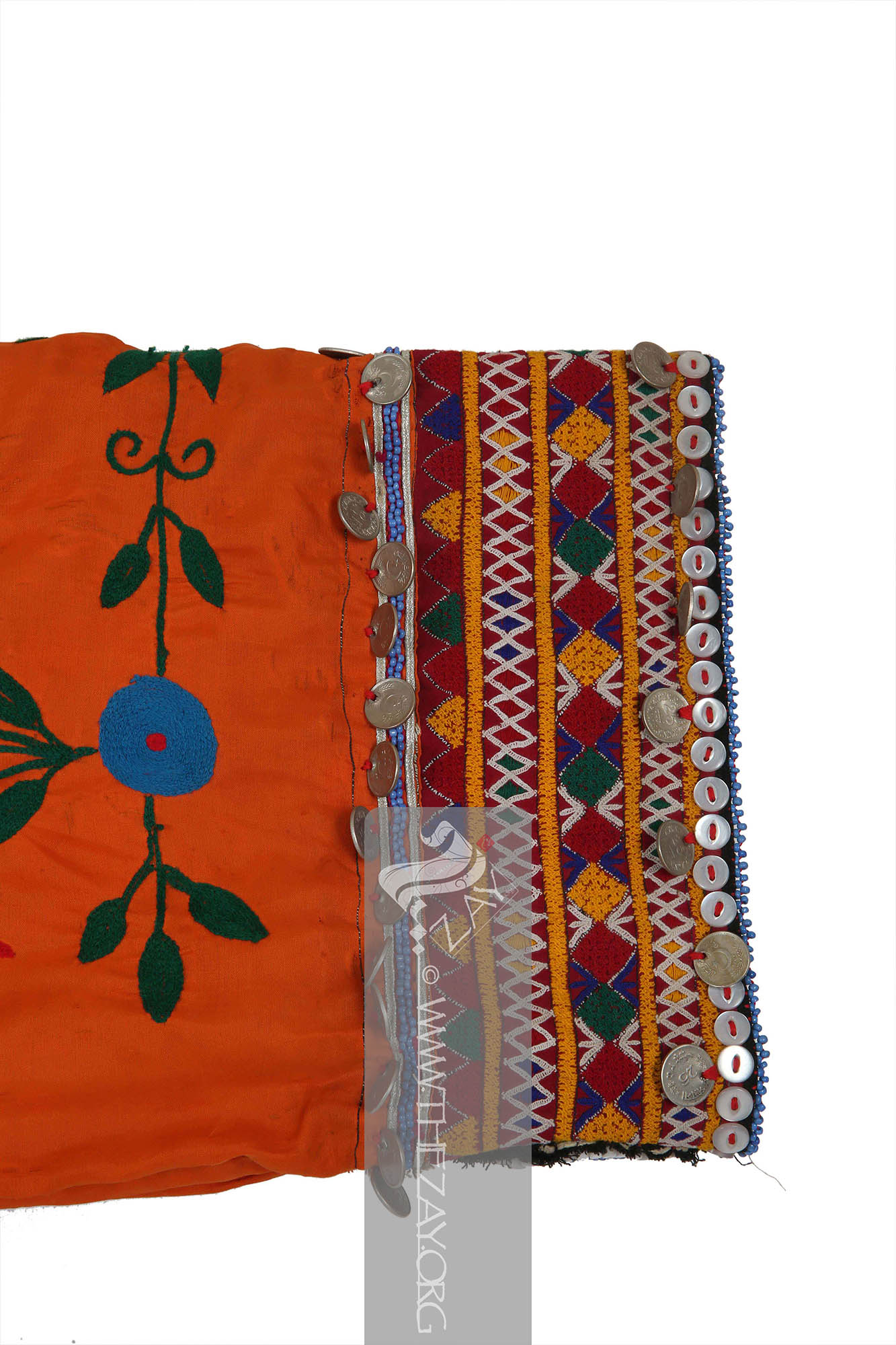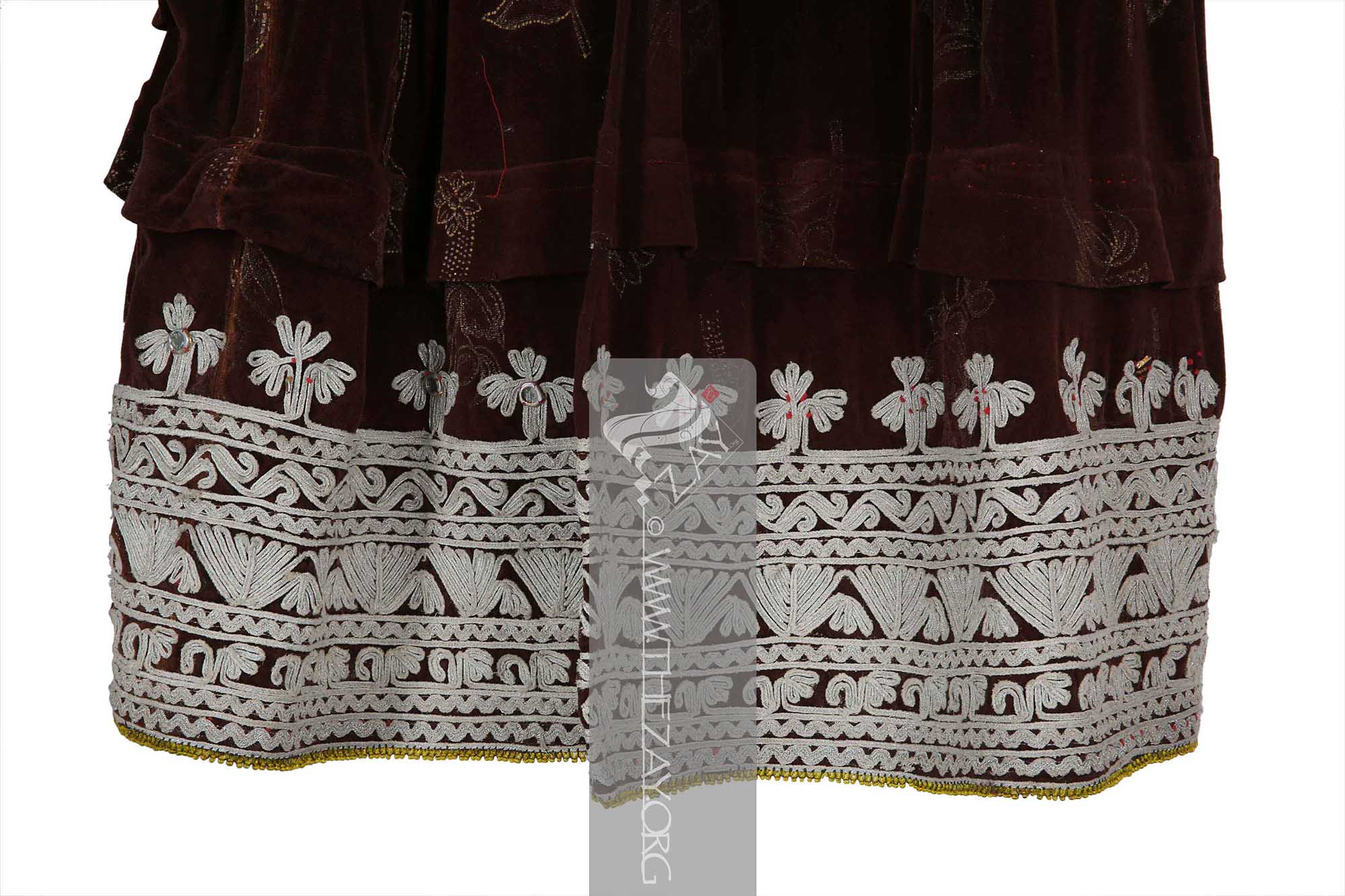Object HistoryThis colourful woman’s tunic native to the Kacchi district of Balochistan province in Pakistan was purchased by
Dr. Reem Tariq
Ṭariq: (Arabic; Synonym: tulle_bi_talli
Tūlle_bi_tallī: (French: Tulle – a city in France where fine material for veil was first made; Turkish: tel – wire; Synonym: tariq; talli; badla; khus_dozi ), series of small metal knots made on a woven net ground as embellishment. The term is commonly used in the North African Arab region specifically in Egypt.
; talli; badla; khus_dozi ), series of small metal knots made on a woven net ground as embellishment. The term is commonly used in the Levant Arab region specifically in Lebanon.
El Mutwalli
Dr. Reem Tariq
Ṭariq: (Arabic; Synonym: tulle_bi_talli
Tūlle_bi_tallī: (French: Tulle – a city in France where fine material for veil was first made; Turkish: tel – wire; Synonym: tariq; talli; badla; khus_dozi ), series of small metal knots made on a woven net ground as embellishment. The term is commonly used in the North African Arab region specifically in Egypt.
; talli; badla; khus_dozi ), series of small metal knots made on a woven net ground as embellishment. The term is commonly used in the Levant Arab region specifically in Lebanon.
el Mutwallī: Founder (CEO) of the Zay
Zay: (Arabic: costume, Pl. azyaā’), a set of clothes in a style typical of a particular country or historical period. Initiative, a public figure, speaker and author. An expert curator and consultant in Islamic art and architecture, interior design, historic costume, and UAE heritage. at the Sharjah Islamic market (suq), recently named The Blue Souk – an outstanding market for antiques in the UAE – in 1997. It was eventually added to The
Zay
Zay: (Arabic: costume, Pl. azyaā’), a set of clothes in a style typical of a particular country or historical period. Initiative to enhance its collection.
Object Features This is a typical woman’s dress from the Kochi nomadic tribes – also colloquially Kacchi – primarily from Afghanistan but also native to parts of Pakistan and Iran. It has a brown velvet skirt and an orange silk
bodice
Bodice: (English: body), or bodices the plural form of body, it is the close-fitting garment meant to cover the body above the waist or the torso. However, it was not until the 17th century that the term became synonymous to women’s undergarment. .
It is heavily embroidered with (
suzani
Suzani: (Farsi: suzandozi : needlework, from Farsi: suzan: needle, dozi: embellishment), type of embroidered and decorative Central Asian tribal textile art usually on a cotton fabric, embroidered in both silk or cotton thread with primarily chain, satin, and buttonhole stitches as well as couching technique. ) style embroidery in a variety of coloured wool using heavy (
blanket_stitch
Blanket_stitch: A basic sewing stitch used to secure the edges of fabric or create decorative borders by looping the thread over the edges of blankets, quilts, and other fabrics and pulling it through, forming a series of evenly spaced stitches that resemble a chain. ) and (
chain_stitch
Chain_stitch: An embroidery technique where a looped stitch is made in a continuous chain-like pattern. Each stitch is formed by looping the thread through the previous stitch, creating a linked chain. ). It has been heavily embellished with tightly beaded ornamental elements or (
gul_i_peron
Gul_i_peron: (Farsi and Urdu: Gul – Flower; or Turkish: Rose; Farsi and Urdu: Pairahan – Garment or Shirt), a fabric embellishment craft of ancient Persian origin involving heavy beadwork often featuring floral motifs and a mirror centrepiece to deflect evil eye from the wearer. It is still famous in South and Central Asia. ) composed of multi-coloured plastic beads on the (
bodice_yoke
Bodice_Yoke: (Synonym: Yoke
Yoke: (Synonym: Bodice_Yoke), a structured pattern fitted at the shoulders defining the structure of women’s garments. Introduced in c. 1880s it defines the transition between the upper and lower parts of the garments and can now be found stitched-in where the blouse is separated from the skirt by a horizontal seam. ), a structured pattern fitted at the shoulders defining the structure of women’s garments. Introduced in c. 1880s it defines the transition between the upper and lower parts of the garments and can now be found stitched-in where the blouse is separated from the skirt by a horizontal seam. )/(
yoke
Yoke: (Synonym: Bodice_Yoke), a structured pattern fitted at the shoulders defining the structure of women’s garments. Introduced in c. 1880s it defines the transition between the upper and lower parts of the garments and can now be found stitched-in where the blouse is separated from the skirt by a horizontal seam. ) – front and back – and the sleeves. Apart from the beads and thread work, the dress is also embellished with an array of plastic buttons and coins of denomination of 25 p. that reads “Hukumat Pakistan” or Government of Pakistan in Urdu minted in Pakistan c.1991.
Apart from that, the piece has corded tassels with plastic beads in orange, blue purple, red and mustard with plum, green, red, black and purple woollen threads. The lining in the piece is mostly linen and cotton with quilted-style running stitches.
The sleeves are broad and loose also packed with geometric
gul_i_peron
Gul_i_peron: (Farsi and Urdu: Gul – Flower; or Turkish: Rose; Farsi and Urdu: Pairahan – Garment or Shirt), a fabric embellishment craft of ancient Persian origin involving heavy beadwork often featuring floral motifs and a mirror centrepiece to deflect evil eye from the wearer. It is still famous in South and Central Asia. beading embellishment as well as
suzani
Suzani: (Farsi: suzandozi : needlework, from Farsi: suzan: needle, dozi: embellishment), type of embroidered and decorative Central Asian tribal textile art usually on a cotton fabric, embroidered in both silk or cotton thread with primarily chain, satin, and buttonhole stitches as well as couching technique. embroidered embellishment in yellow, green, and red, and two different shades of blue, ivory and pink. The front opening of the
yoke
Yoke: (Synonym: Bodice_Yoke), a structured pattern fitted at the shoulders defining the structure of women’s garments. Introduced in c. 1880s it defines the transition between the upper and lower parts of the garments and can now be found stitched-in where the blouse is separated from the skirt by a horizontal seam. has hook and eye fastenings.
The back of the
yoke
Yoke: (Synonym: Bodice_Yoke), a structured pattern fitted at the shoulders defining the structure of women’s garments. Introduced in c. 1880s it defines the transition between the upper and lower parts of the garments and can now be found stitched-in where the blouse is separated from the skirt by a horizontal seam. has a printed woollen rectangular patch with pink floral and green foliage motifs. Small mirrors are sewn into the patch as embellishment along with floral and geometric motifs embroidered in shiny red metallic thread.
The hem of the skirt has a broad border in ivory wool and silver metal foil wrapped around the woollen threads and silver-coloured metal cords. It is further secured at the underside with a blue cotton fabric with quilting style running stitch that also serves as a lining to the embroidered part of the skirt thus preventing the embroidered materials from uncomfortably rubbing against the skin of the wearer as well as preventing the embroidery from easy damage.
The edging of the skirt is finished with a series of yellow plastic beading. It is a front-open girl’s / woman’s dress with a high waist. The back of the
yoke
Yoke: (Synonym: Bodice_Yoke), a structured pattern fitted at the shoulders defining the structure of women’s garments. Introduced in c. 1880s it defines the transition between the upper and lower parts of the garments and can now be found stitched-in where the blouse is separated from the skirt by a horizontal seam. and the underarms also have patchwork.
One side of the skirt has a pocket the edges of which are decorated with a broad band of beading, and
suzani
Suzani: (Farsi: suzandozi : needlework, from Farsi: suzan: needle, dozi: embellishment), type of embroidered and decorative Central Asian tribal textile art usually on a cotton fabric, embroidered in both silk or cotton thread with primarily chain, satin, and buttonhole stitches as well as couching technique. embroidered woollen trims with mirror work. The brown velvet skirt is splattered with a repeat of floral motifs executed with metal and glitter pasted to the skirt – a technique very famous during c. The 1990s throughout South Asia. The skirt also displays a distinct frill that is made by folding the fabric of the skirt and stitching it in the underside.
Interestingly, most of these dresses that are found in the West today are samples from c. 1970s Afghanistan. Although traditional women’s dresses of nomadic pastoral tribes, the flamboyancy of these dresses became synonymous with Afghanistan thus identifying the country to the west, especially during the hippie era.
Links
- Valérie Bérinstain, Mary Hunt Kahlenberg, Zaira Mis, Marcel Mis. Asian Costumes and Textiles from the Bosphorus to Fujiyama: The Zaira and Marcel Mis Collection. California: Skira, 2001.
- Suleman, Fahmida. Textiles of the Middle East and Central Asia (British Museum) The Fabric of Life. London: Thames and Hudson, 2017.
- Embroidery from Afghanistan Fabric, folios. Sheila Paine. Washington: University of Washington Press, 2006.
- Sukhareva, Olʹga Aleksandrovna. Suzani
Suzani: (Farsi: suzandozi : needlework, from Farsi: suzan: needle, dozi: embellishment), type of embroidered and decorative Central Asian tribal textile art usually on a cotton fabric, embroidered in both silk or cotton thread with primarily chain, satin, and buttonhole stitches as well as couching technique. : Central Asian Decorative Embroidery. Samarkand: SMI Asia, 2013.
- https://referenceworks.brillonline.com/entries/encyclopaedia-iranica-online/clothing-COM_7759?lang=fr#COM-10186
- https://trcleiden.nl/trc-digital-exhibition/index.php/dressing-the-stans/item/109-decorative-needlework
- https://trc-leiden.nl/trc-digital-exhibition/index.php/afghan-dress/item/72-hamid-karzai-and-afghan-unification
- https://trc-leiden.nl/trc-digital-exhibition/index.php/afghan-dress/item/74-baluchi-dress
- https://www.wearableheritage.com/gul-i-peron
- https://www.ancientbeadwork.com/gul-i-peron
- https://trc-leiden.nl/trc-digital-exhibition/index.php/afghan-dress/item/77-pashtun-dress








